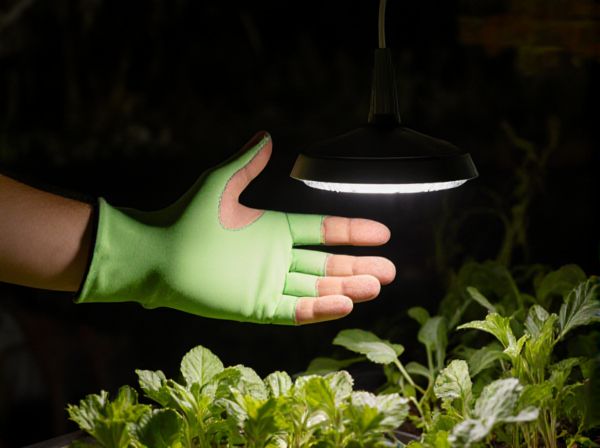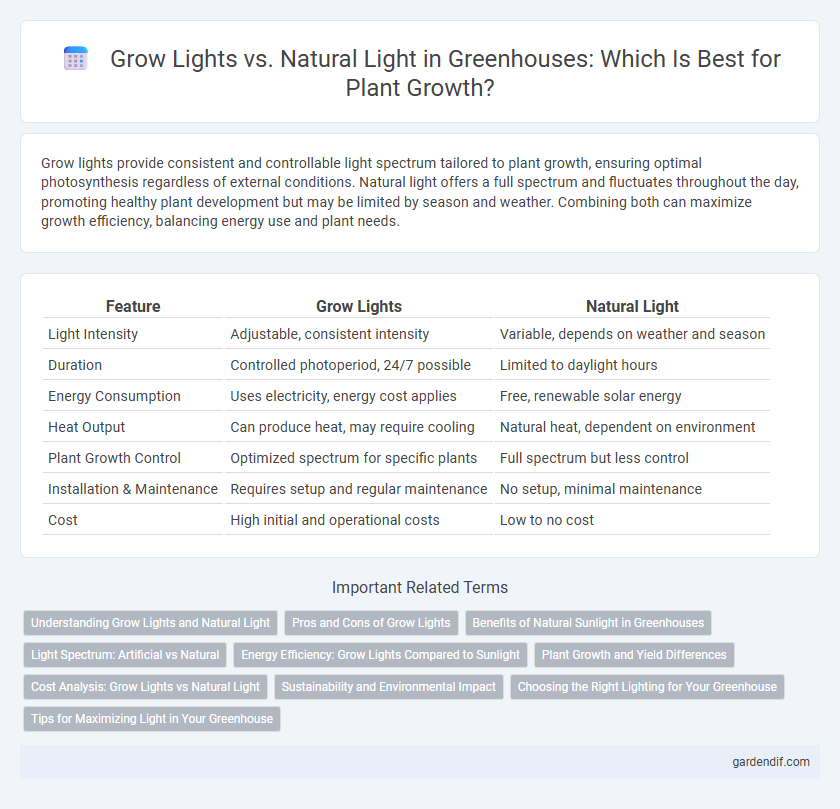
Grow Lights vs Natural Light Illustration
Grow lights provide consistent and controllable light spectrum tailored to plant growth, ensuring optimal photosynthesis regardless of external conditions. Natural light offers a full spectrum and fluctuates throughout the day, promoting healthy plant development but may be limited by season and weather. Combining both can maximize growth efficiency, balancing energy use and plant needs.
Table of Comparison
| Feature | Grow Lights | Natural Light |
|---|---|---|
| Light Intensity | Adjustable, consistent intensity | Variable, depends on weather and season |
| Duration | Controlled photoperiod, 24/7 possible | Limited to daylight hours |
| Energy Consumption | Uses electricity, energy cost applies | Free, renewable solar energy |
| Heat Output | Can produce heat, may require cooling | Natural heat, dependent on environment |
| Plant Growth Control | Optimized spectrum for specific plants | Full spectrum but less control |
| Installation & Maintenance | Requires setup and regular maintenance | No setup, minimal maintenance |
| Cost | High initial and operational costs | Low to no cost |
Understanding Grow Lights and Natural Light
Grow lights simulate natural light by providing specific wavelengths essential for photosynthesis, enabling consistent plant growth regardless of outdoor conditions. Natural light offers a full spectrum of sunlight that varies with time and weather, influencing plant development cycles and intensity. Understanding the balance between grow lights and natural light helps optimize photosynthetic efficiency and maximize crop yields in greenhouse environments.
Pros and Cons of Grow Lights
Grow lights provide consistent light intensity and spectrum control, essential for optimal photosynthesis and year-round crop production in greenhouses. However, they consume significant energy and may increase operational costs compared to natural light. Despite upfront investment, grow lights enhance plant growth during low sunlight periods, improving yield and reducing dependency on weather fluctuations.
Benefits of Natural Sunlight in Greenhouses
Natural sunlight provides a full spectrum of light essential for photosynthesis, enhancing plant growth and development in greenhouses. It supports higher energy efficiency by reducing the need for artificial lighting, lowering operational costs and environmental impact. Plants exposed to natural sunlight typically exhibit stronger stems, more vibrant foliage, and improved overall health compared to those relying solely on grow lights.
Light Spectrum: Artificial vs Natural
Grow lights emit specific wavelengths tailored to plant photosynthesis, commonly offering red and blue spectra that maximize growth efficiency. Natural light delivers a full spectrum, including ultraviolet and infrared rays, promoting overall plant health and development beyond photosynthesis alone. Balancing artificial and natural light spectra can optimize plant growth by combining precision with the comprehensive benefits of sunlight.
Energy Efficiency: Grow Lights Compared to Sunlight
Grow lights offer controlled energy consumption optimized for plant growth cycles, using LED technology to minimize electricity costs compared to traditional lighting. Natural sunlight provides free, full-spectrum energy but fluctuates with weather and daylight hours, impacting consistent plant development. Efficient grow light systems can complement natural sunlight to maintain steady energy efficiency in greenhouse environments year-round.
Plant Growth and Yield Differences
Grow lights provide consistent, controllable light spectra that enhance photosynthesis and promote faster plant growth compared to variable natural light conditions. Studies show that plants grown under optimized LED grow lights can achieve up to 20-30% higher yields and improved crop quality due to tailored light intensity and duration. Natural light, while beneficial for its full spectrum and UV content, is often limited by weather and seasons, resulting in less predictable growth and lower productivity.
Cost Analysis: Grow Lights vs Natural Light
Grow lights require an initial investment typically ranging from $100 to $500 per unit and consume electricity costs of approximately $20 to $50 monthly, depending on usage and light intensity. Natural light, while free, may necessitate supplemental heating or reflective materials to optimize plant growth, potentially adding indirect expenses. Cost analysis reveals that although grow lights incur ongoing energy expenses, they provide consistent light quality and duration, which can enhance crop yields compared to unpredictable natural sunlight conditions.
Sustainability and Environmental Impact
Grow lights provide controlled, consistent light quality for greenhouse plants, enhancing growth efficiency while reducing water usage and pesticide need. Natural light relies on solar energy, minimizing electricity consumption and carbon footprint, but can limit crop cycles due to seasonal variability. Integrating energy-efficient LED grow lights powered by renewable energy sources offers a sustainable balance, optimizing plant growth with reduced environmental impact.
Choosing the Right Lighting for Your Greenhouse
Selecting the right lighting for your greenhouse involves balancing the intensity and spectrum of grow lights with the benefits of natural sunlight to maximize plant growth. LED grow lights provide energy-efficient, customizable light spectrums that can enhance photosynthesis and extend growing hours, especially during low-light seasons. Integrating natural light with supplemental grow lights ensures optimal plant health, productivity, and energy savings throughout the year.
Tips for Maximizing Light in Your Greenhouse
Maximize light in your greenhouse by positioning grow lights to complement natural sunlight, ensuring plants receive consistent and balanced illumination throughout the day. Use reflective surfaces and light-colored walls inside the greenhouse to enhance light distribution and reduce shadows. Regularly clean both grow lights and greenhouse glass to prevent dirt buildup, which can significantly diminish light intensity available to your plants.
Grow Lights vs Natural Light Infographic

 gardendif.com
gardendif.com